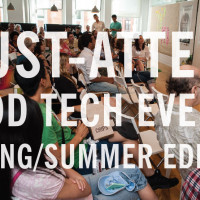Rejecting human centered food design in favor of systems centered food design.
The most important commandment in human centered design is to empathize with the user. Design is all about having a deep understanding of the user and then bending the product or service into shape to create that ideal human experience. Innovation happens when designers can successfully create that ideal experience in the face of constraints — cost, resources, materials, etc.
A classic example of this is seen when the design agency IDEO dutifully observed small children as they brushed their teeth to gain insight on how they might improve the process. They noticed that kids’ tiny hands had trouble gripping conventional, skinny toothbrushes. So after much brainstorming and prototyping, IDEO redesigned the toothbrush handle to be much fatter, thereby making it easier for a 3 year old to hold. It seems like such an obvious move in hindsight — most brilliant designs are — but what it did was bend the current assumptions around the toothbrush in service of a better experience for the users in question.
In food, we’ve grown accustomed to the idea that products and services have been designed with our needs in mind. From having access to cheap tomatoes all year-round, to buying a shatterproof plastic soda bottle with a resealable cap, to being able to buy a virtually identical hamburger in thousands of locations across the world, humans have mastered the art of bending food to our whims.
But while there’s a lot of human empathy in the aforementioned examples, what societal and environmental cost have we borne to attain that empathy? Is fast food so brilliantly empathetic to the user experience of eating that it completely throws empathy for the food system out the window?
Or take the fact that you can pretty much buy any fruit or vegetable all year-round across the country. The whole idea of eating with the seasons has been overcome in service of humans who can’t bear to live without fresh corn and tomatoes in a northern winter. The food industry is more empathetic with that human experience than they are interested in trying to get people to follow nature’s planting season.
As an industry, this extreme empathy (selfishness?) for the user has driven us to create farm subsidies for corn and soy to ensure a permanently cheap supply for food and non-food products. It’s created an international network of food distribution that provides unfettered abundance for all food categories. All of this has created a system that’s bolstered by massive amounts of natural resources and energy that defy the laws of nature. There’s no such thing as, “you can’t have that right now,” because industrial food innovation means never having to say “no.”
As progressive food designers, it’s up to us to have more empathy for the food system in what we create. Maybe if we took geographical constraints more seriously, we’d have a system that didn’t ship tons of fruit and vegetables thousands of miles from their home. Maybe we’d have a food system that was more locally and seasonally based, where humans knew that not everything was within their grasp 365 days of the year.
If this kind of empathy for the food system was held in higher regard, it’s possible that the real innovation challenge would lie in, “how might we get people to eat more locally and seasonally?” not, “how can we eat fresh tomatoes every day?”
Mind you, this is a very first world problem to have. Most third-world countries with real hunger would be happy to bend nature to its wills a bit more because hunger represents a total void in user empathy. But as a society is able to successfully meet its core needs for food, it should have a responsibility to fulfill the goal of leaving the Earth better for the next generation. We can comfortably afford to have less empathy for the user and more for the food system, so we certainly should.
Extreme empathy for the food user worked for a while, but with fossil fuels dwindling and climate change impending, we no longer have the luxury of ignoring the needs of our natural ecosystem.






